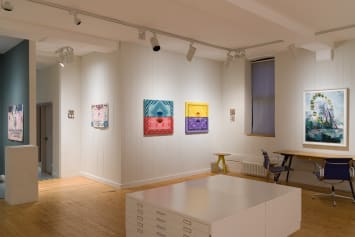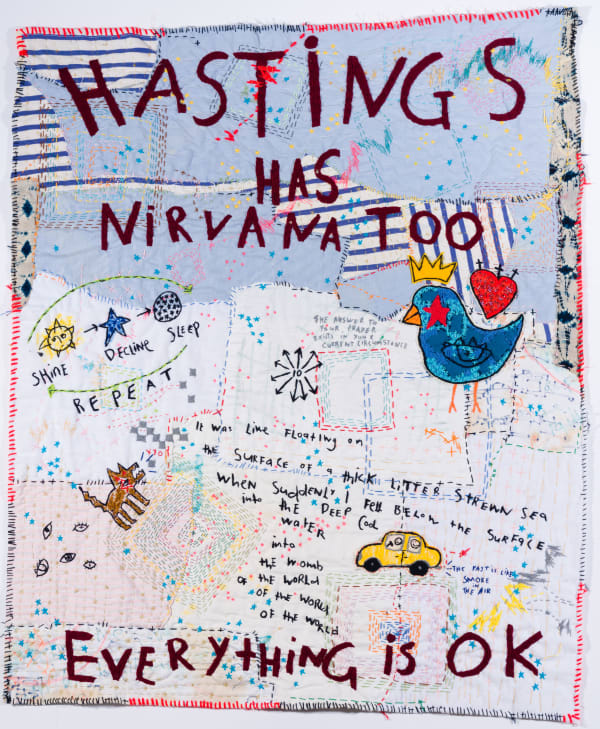Each year Platform focuses on a single distinct theme, the section includes galleries presenting well-known, overlooked and emerging artists that align to the theme.
At a time when the world is ever changing, curator Candida Stevens presents Folk Art, a view to our cultural heritage, our communities and our identity and how artists who are working in the Folk tradition have chosen to pass on this cultural heritage of knowledge and inspiration.
Cultural heritage is unique and irreplaceable, it is an expression of the ways of living, developed over time by a community and passed on from generation to generation. It can include customs, practices, places, objects, artistic expressions and values. The cultural heritage of a community reflects and shapes values, beliefs, and aspirations helping to define people’s national identity.
-
Anthony Stevens is fascinated and inspired by the spiritual utility that is often infused in traditional folk art. An art form that to his mind is deeply imbued with longing, hope and a great depth of soul. By looking at myths and archetypal figures including Bodhisattva Avalokiteshvara and Persephone and Demeter, as well as considering traditional forms of making such as quilting, Anthony explores the positive potentials that are hidden in the shared human experiences of heartbreak, loss and confusion, potentials that can become manifest in part through the process of art and making, and the comfort it can bring to both maker and observer.
-
-
![Cecilia Charlton, The dawn of a new day [purple and yellow], 2020](data:image/gif;base64,R0lGODlhAQABAIAAAAAAAP///yH5BAEAAAAALAAAAAABAAEAAAIBRAA7)
-
-

Katharine Le Hardy
Let Them Play, 2020During the early months of 2020, with access to the physical world restricted by a national lockdown, Katharine Le Hardy found herself absorbed by historical images of past times. Partially induced by memory and partly by nostalgia she started painting historic images of places and children at play. This triggered a new enquiry, an investigation of the space between the real, the past, the lost and the hopeful. Currently documenting deserted funfairs, and researching the history of play, Katharine observes the forlornness of a deserted place of play and how this conflicts with our presupposed associations of jubilance, how our memories entwine with our fantasies. In this work we see a curious balance between the whimsical and the absolute. There is a universal cultural heritage of certain childhood games, amongst the most enduring are the hula hoop, hopscotch, puddles, skipping and balls. The children in Le Hardy’s paintings appear in western style 1920’s clothing emphasising the passage of time. Certain games have been passed down from generation to generation for hundreds of years demonstrating the elemental importance and significance of togetherness and play.
-
-
Platform, London Art Fair, interviews with the artists
January 19, 2021Candida Stevens presents three artists who look at history. Katharine Le Hardy explores the cultural heritage of play, recording the most universally enduring childhood games, demonstrating the elemental importance and...









![Cecilia Charlton, The dawn of a new day [purple and yellow], 2020](https://artlogic-res.cloudinary.com/w_620,h_620,c_limit,f_auto,fl_lossy,q_auto/artlogicstorage/candidastevens/images/view/52d5a35c65712d4cf518b9f82a5c626dj.jpg)
![Cecilia Charlton, A certain slant of light (labyrinthine pathways of diamonds) [triptych], 2020](https://artlogic-res.cloudinary.com/w_600,c_limit,f_auto,fl_lossy,q_auto/artlogicstorage/candidastevens/images/view/b7e05ff7c7b7b652646139ca9108e387j/candidastevens-cecilia-charlton-a-certain-slant-of-light-labyrinthine-pathways-of-diamonds-triptych-2020.jpg)

![Cecilia Charlton, On a blue sky day [ce n'est pas une couette], 2020](https://artlogic-res.cloudinary.com/w_600,c_limit,f_auto,fl_lossy,q_auto/artlogicstorage/candidastevens/images/view/9301c7e514489482382c60059b0f9a17/candidastevens-cecilia-charlton-on-a-blue-sky-day-ce-n-est-pas-une-couette-2020.jpg)
![Cecilia Charlton, Quilted Composition [awkward painting 2], 2020](https://artlogic-res.cloudinary.com/w_600,c_limit,f_auto,fl_lossy,q_auto/artlogicstorage/candidastevens/images/view/218fa44b2d13bd4f9ff645eced3b5516/candidastevens-cecilia-charlton-quilted-composition-awkward-painting-2-2020.jpg)
![Cecilia Charlton, Quilted Composition [awkward painting 3], 2020](https://artlogic-res.cloudinary.com/w_600,c_limit,f_auto,fl_lossy,q_auto/artlogicstorage/candidastevens/images/view/14aa31e833b13acb400686f24af10545/candidastevens-cecilia-charlton-quilted-composition-awkward-painting-3-2020.jpg)
![Cecilia Charlton, The dawn of a new day [blue and red], 2020](https://artlogic-res.cloudinary.com/w_600,c_limit,f_auto,fl_lossy,q_auto/artlogicstorage/candidastevens/images/view/f75f2cdf269cfa968e8b070bc6142907j/candidastevens-cecilia-charlton-the-dawn-of-a-new-day-blue-and-red-2020.jpg)
![Cecilia Charlton, The dawn of a new day [purple and yellow], 2020](https://artlogic-res.cloudinary.com/w_600,c_limit,f_auto,fl_lossy,q_auto/artlogicstorage/candidastevens/images/view/52d5a35c65712d4cf518b9f82a5c626dj/candidastevens-cecilia-charlton-the-dawn-of-a-new-day-purple-and-yellow-2020.jpg)
![Cecilia Charlton, Triple-layer gather-gusset [green-blue northern lights], 2019](https://artlogic-res.cloudinary.com/w_600,c_limit,f_auto,fl_lossy,q_auto/artlogicstorage/candidastevens/images/view/0b6c13627e24d7288e1cc57808ec4ec7j/candidastevens-cecilia-charlton-triple-layer-gather-gusset-green-blue-northern-lights-2019.jpg)








